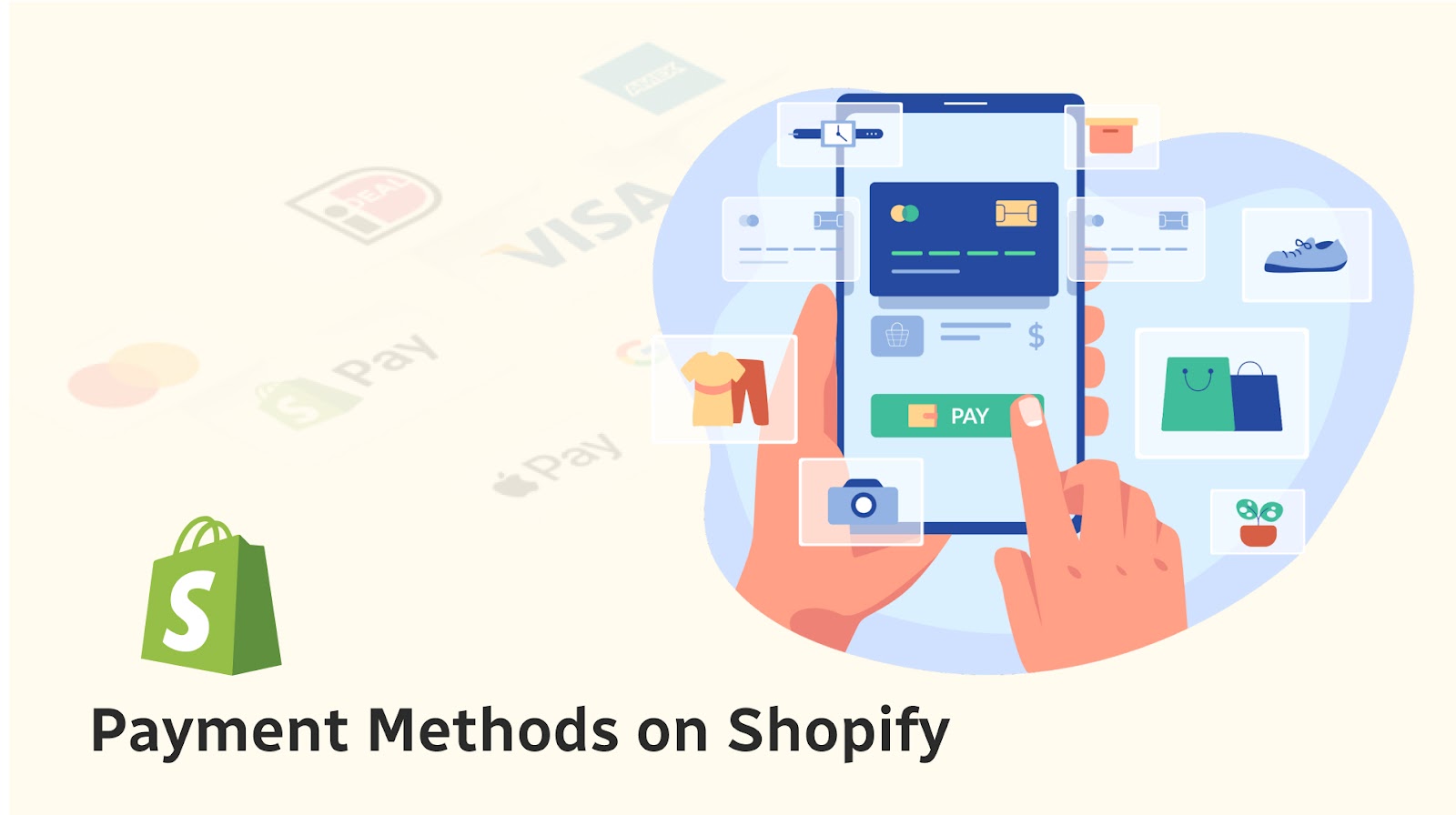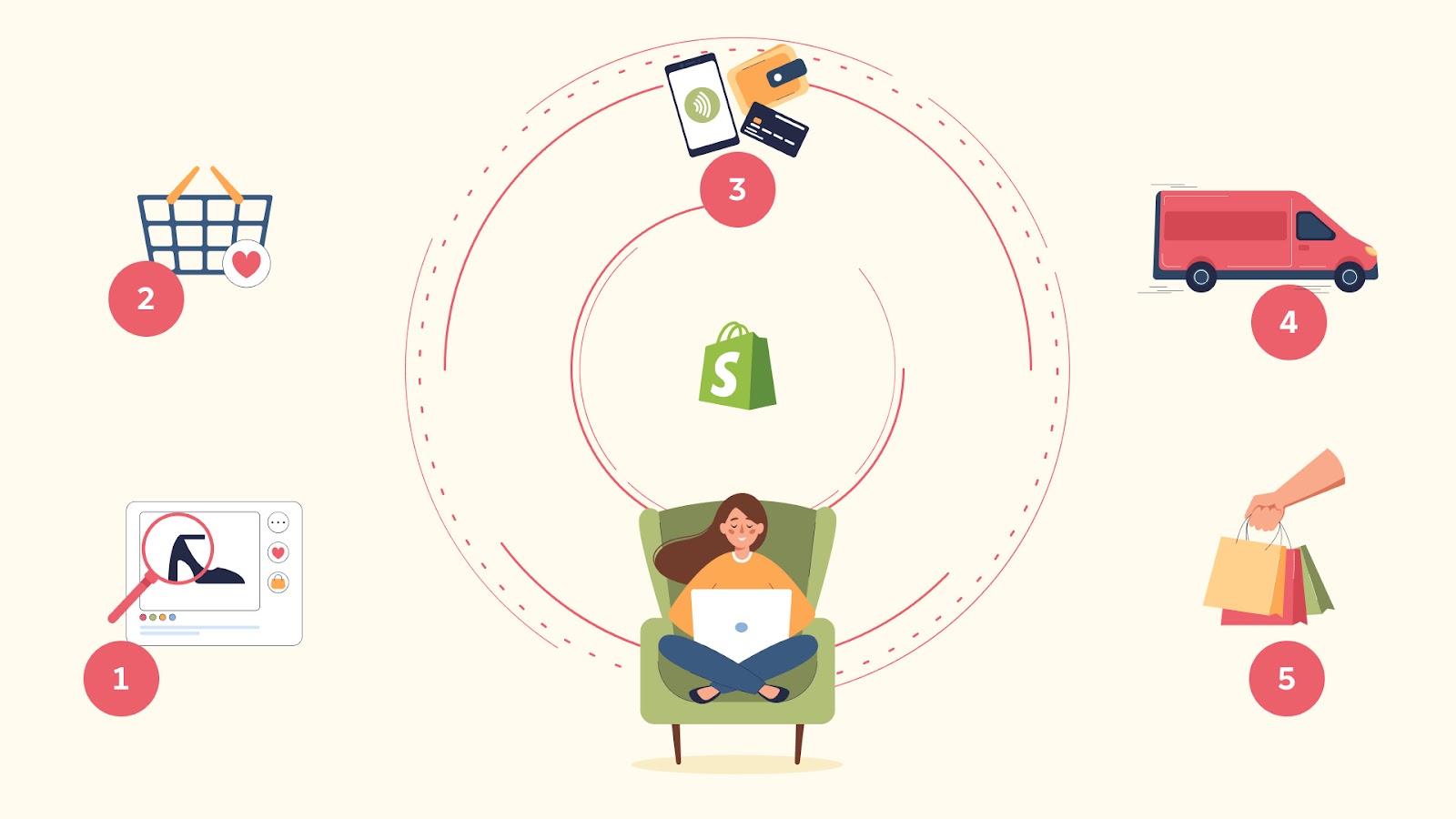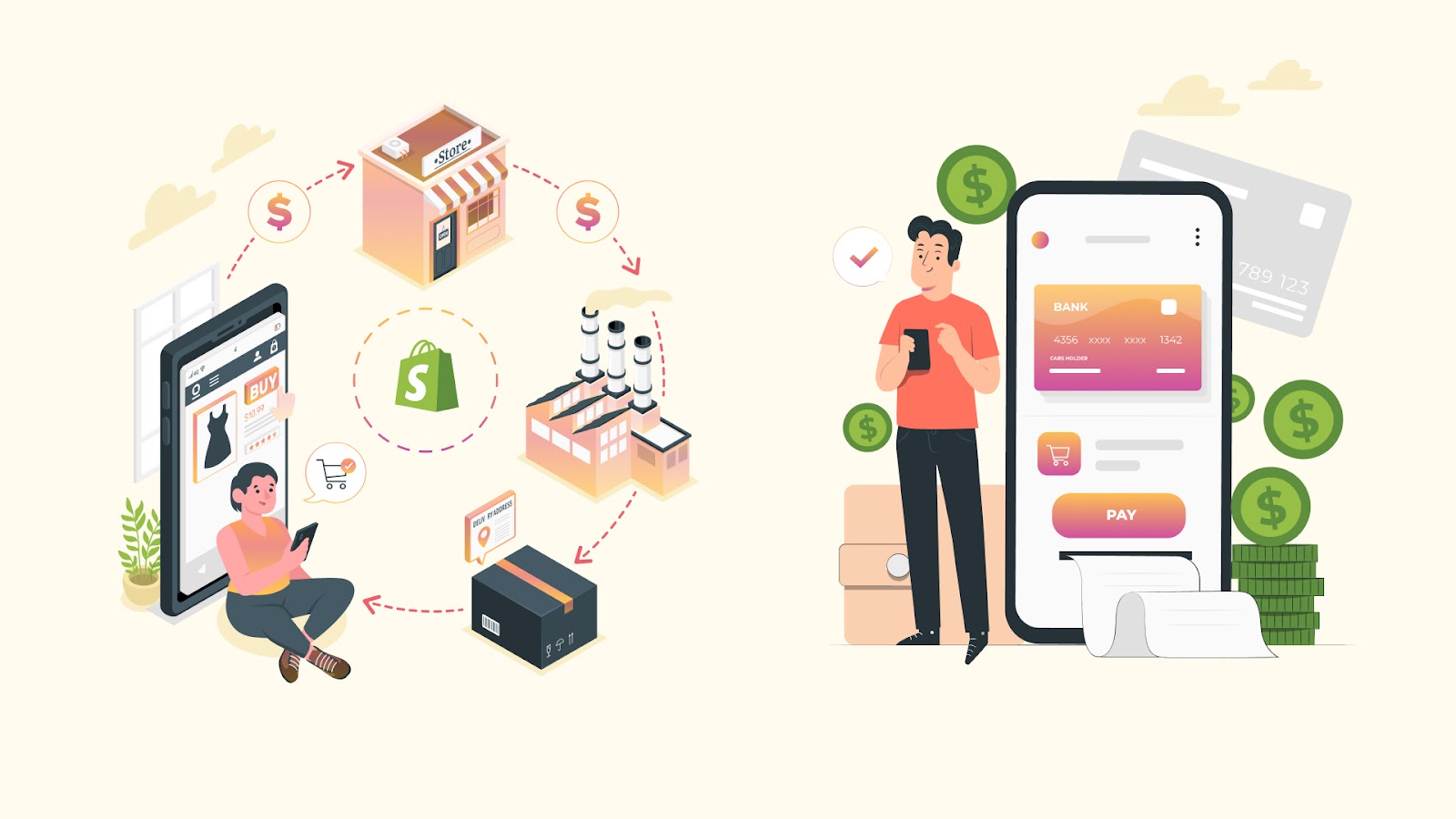- Table of Contents
- Introduction
- Payment Methods on Shopify
- Shipping Methods on Shopify
- Payment and Shipping Automation on Shopify
- Advanced Payment and Shipping Techniques on Shopify
- Payment and Shipping Optimization on Shopify
- Conclusion
Introduction
In e-commerce, payment and shipping methods are crucial components of the customer experience. Payment methods enable customers to securely and conveniently complete transactions, while shipping methods ensure that products are delivered to customers in a timely and reliable manner. The availability of diverse payment and shipping options can increase customer satisfaction, build trust, and encourage repeat business. Therefore, e-commerce businesses need to offer a variety of payment and shipping methods that are easy to use, reliable, and secure.
Significance of Shopify as an e-commerce platform
Shopify is a popular e-commerce platform that provides businesses with an all-in-one solution for online selling. It offers a wide range of features and tools that help businesses easily create and manage their online stores, including website design, product management, order tracking, and marketing. Shopify also provides a range of payment and shipping options that can be easily integrated into online stores, making it easy for businesses to offer their customers convenient and secure payment and shipping methods. Shopify is also known for its robust security features, which help to protect customer data and prevent fraud. Overall, Shopify is a powerful platform that enables businesses of all sizes to establish an online presence and streamline their e-commerce operations.
Payment Methods on Shopify

Various payment methods available on Shopify
Shopify offers a wide range of payment methods that businesses can integrate into their online stores to accept payments from customers. These payment methods include:
- Credit and Debit Cards: Shopify supports a wide range of credit and debit cards, including Visa, Mastercard, American Express, and Discover.
- PayPal: Customers can pay for purchases using their PayPal account, which is a popular and widely used digital wallet.
- Apple Pay: Customers with Apple devices can use Apple Pay to complete transactions quickly and easily.
- Google Pay: Customers with Android devices can use Google Pay to make payments.
- Shopify Payments: This is a payment gateway that enables businesses to accept credit card payments directly on their Shopify store without the need for a third-party payment processor.
- Alternative Payment Methods: Shopify also supports alternative payment methods such as cryptocurrencies, digital wallets, and bank transfers.
Payment gateway integration with Shopify
Payment gateway integration with Shopify enables businesses to securely process payments from their customers. A payment gateway is a software application that acts as a link between the customer’s payment method and the business’s bank account.
Shopify offers integration with a wide range of payment gateways, including popular options like PayPal, Stripe, Authorize.Net, and Braintree. To integrate a payment gateway with Shopify, businesses need to first set up an account with the payment gateway provider and then connect it to their Shopify store.
Once the payment gateway is integrated, customers can securely enter their payment information during the checkout process, and the payment gateway will process the transaction and transfer the funds to the business’s bank account.
Payment gateway integration is a critical component of e-commerce, as it ensures that customer payments are processed securely and reliably. Shopify’s extensive range of payment gateway options makes it easy for businesses to find a provider that meets their specific needs and preferences.
Comparison of transaction fees and pricing structures
Transaction fees and pricing structures are important factors to consider when selecting a payment gateway for your Shopify store. Transaction fees refer to the percentage of the sale that is charged by the payment gateway for processing the transaction. Pricing structures can vary between payment gateways, with some charging a flat fee per transaction, while others charge a percentage-based fee.
Here’s a comparison of the transaction fees and pricing structures for some of the most popular payment gateways available on Shopify:
- Shopify Payments: Shopify Payments charges a transaction fee of 2.9% + 30 cents per transaction for US-based businesses. International businesses may incur higher fees.
- PayPal: PayPal charges a transaction fee of 2.9% + 30 cents per transaction for US-based businesses. International businesses may incur higher fees.
- Stripe: Stripe charges a transaction fee of 2.9% + 30 cents per transaction for US-based businesses. International businesses may incur higher fees.
- Authorize.Net: Authorize.Net charges a monthly gateway fee of $25 and a per-transaction fee of 2.9% + 30 cents.
- Braintree: Braintree charges a transaction fee of 2.9% + 30 cents per transaction for US-based businesses. International businesses may incur higher fees.
When selecting a payment gateway for your Shopify store, it’s important to consider not only the transaction fees and pricing structures, but also other factors such as ease of use, security features, and customer support. By comparing the various payment gateway options available on Shopify, you can find the one that best meets your needs and helps you to maximize profits while minimizing costs.
Implementation of fraud prevention measures
Fraud prevention is a critical aspect of e-commerce, as it helps to protect both the business and its customers from fraudulent activity. Shopify provides a range of built-in fraud prevention measures that can be easily implemented to help reduce the risk of fraud. Here are some of the key measures:
- Address Verification System (AVS): AVS checks the billing address entered by the customer during checkout against the address on file with the credit card issuer.
- Card Verification Value (CVV): CVV is a three- or four-digit code located on the back of credit and debit cards. Shopify requires customers to enter this code during checkout to verify that they have the physical card in their possession.
- Risk Analysis: Shopify’s risk analysis algorithm examines multiple factors, including the customer’s order history, IP address, and location, to identify potentially fraudulent activity.
- Fraud Filters: Shopify offers a range of customizable fraud filters that allow businesses to identify and block high-risk transactions.
- Chargeback Protection: Shopify’s chargeback protection program helps businesses to recover lost revenue in cases where a customer disputes a charge.
In addition to these built-in measures, there are also third-party fraud prevention services that can be integrated into Shopify stores. These services offer more advanced fraud detection and prevention capabilities, such as machine learning algorithms that can identify patterns of fraudulent behavior.
By implementing these fraud prevention measures, businesses can reduce the risk of fraudulent activity, protect their customers’ data and transactions, and minimize the impact of chargebacks on their revenue.
Best practices for optimizing the payment process
Optimizing the payment process is crucial for improving the customer experience and increasing conversions on your Shopify store. Here are some best practices to follow:
- Provide multiple payment options: Offer a range of payment options, including credit/debit cards, PayPal, and other popular payment methods, to accommodate different customer preferences.
- Streamline the checkout process: Minimize the number of steps required to complete a purchase and eliminate unnecessary form fields to reduce friction and make checkout as easy as possible.
- Display security badges: Display security badges and SSL certificates prominently during checkout to reassure customers that their payment information is secure.
- Optimize for mobile: Make sure that your checkout process is optimized for mobile devices, with large buttons and easy-to-use forms.
- Avoid unexpected fees: Be transparent about any additional fees, such as shipping or tax, and make sure that they are displayed before the customer completes their purchase.
- Personalize the payment experience: Use customer data and past purchase history to personalize the payment experience, such as by offering recommended products or discounts.
- Provide order confirmation and tracking: Provide customers with an order confirmation and tracking information as soon as their order is processed, to help them track their package and stay informed about their purchase.
Shipping Methods on Shopify

Various shipping methods available on Shopify
Shopify offers a range of shipping methods to help businesses fulfill orders and deliver products to their customers. Here are some of the key shipping methods available on Shopify:
- Carrier Calculated Shipping: This method allows businesses to integrate with third-party carriers, such as UPS, FedEx, or USPS, to calculate shipping rates based on weight, destination, and other factors.
- Flat Rate Shipping: This method charges a fixed rate for shipping, regardless of the weight or destination of the package.
- Free Shipping: This method allows businesses to offer free shipping on certain products or orders, either as a promotion or a standard offering.
- Local Delivery: This method allows businesses to offer local delivery options to customers within a certain radius of their store or warehouse.
- In-Store Pickup: This method allows customers to pick up their orders directly from the store or warehouse, eliminating shipping fees and wait times.
- Custom Shipping Rules: Shopify also offers a range of custom shipping rules, such as product-specific shipping rates, shipping discounts for high-volume orders, and more.
By offering a range of shipping methods, businesses can accommodate different customer needs and preferences, and provide a more flexible and convenient shopping experience. Shopify also offers a range of shipping integrations and apps, such as ShipStation, Shippo, and EasyShip, that can help businesses streamline their shipping operations and improve efficiency.
Calculation of shipping rates and delivery timeframes
Calculating accurate shipping rates and delivery timeframes is crucial for providing a positive customer experience and avoiding disputes and chargebacks. Here are some factors that can impact shipping rates and timeframes on Shopify:
- Package weight and dimensions: Shipping rates are typically calculated based on the weight and dimensions of the package. Shopify allows businesses to enter this information for each product, which can be used to calculate shipping rates during checkout.
- Destination and shipping method: Shipping rates can also vary based on the destination and shipping method selected by the customer. For example, international shipping rates may be higher than domestic rates, and expedited shipping may cost more than standard shipping.
- Carrier rates: Shipping rates can also be influenced by carrier rates, which may vary depending on the carrier and the business’s shipping volume.
- Delivery timeframe: The estimated delivery time frame can depend on the shipping method selected, the carrier used, and the destination of the package.
To calculate accurate shipping rates and timeframes on Shopify, businesses can integrate with carrier calculators such as USPS, FedEx, or UPS, or use third-party apps that offer shipping rate and delivery timeframe calculations based on various factors.
To ensure that customers are provided with accurate shipping rates and delivery timeframes, businesses should display shipping information clearly during checkout and provide tracking information as soon as the order is fulfilled. They should also set realistic delivery expectations and ensure that they have a reliable shipping and fulfillment process in place to meet those expectations.
Integration of third-party shipping carriers
Shopify allows businesses to integrate with third-party shipping carriers to streamline their shipping operations and improve efficiency. Here are some of the benefits of integrating with third-party shipping carriers:
- More shipping options: Integrating with multiple carriers allows businesses to offer a wider range of shipping options to their customers, including domestic and international shipping, expedited shipping, and more.
- Automatic rate calculations: By integrating with carrier calculators, businesses can automatically calculate shipping rates based on factors such as weight, destination, and shipping method.
- Label printing and tracking: Integrating with carriers can also enable businesses to print shipping labels and provide tracking information directly from the Shopify dashboard, saving time and reducing errors.
- Improved order fulfillment: By automating the shipping process, businesses can improve their order fulfillment speed and accuracy, which can lead to higher customer satisfaction and repeat business.
To integrate with a third-party shipping carrier on Shopify, businesses can use one of the carrier integrations available in the Shopify App Store, such as USPS, FedEx, or UPS. They can also use third-party shipping apps that offer integrations with multiple carriers, such as Shippo or EasyShip.
Once the integration is set up, businesses can configure their shipping settings in Shopify to enable the new shipping options and rates. They can also set up automation rules to streamline the fulfillment process and provide a seamless shipping experience for their customers.
Implementation of package tracking and delivery notifications
Implementing package tracking and delivery notifications can help businesses provide a better customer experience and reduce customer inquiries related to order status. Here are some best practices for implementing package tracking and delivery notifications on Shopify:
- Use a reliable carrier: Using a reliable carrier with a good track record for timely and accurate delivery can help ensure that package tracking and delivery notifications are accurate and up-to-date.
- Enable tracking information: In Shopify, businesses can enable tracking information for each order, which allows customers to track the status of their package and receive notifications when it’s shipped, in transit, and delivered.
- Configure notification settings: Shopify allows businesses to configure their notification settings for shipping updates, including the frequency and type of notifications sent to customers. Businesses can also customize the messaging and branding of these notifications to match their brand.
- Provide delivery updates: In addition to tracking information, businesses can also provide delivery updates such as estimated delivery timeframes and delivery confirmation notifications to keep customers informed and reduce anxiety around package delivery.
- Offer customer support: Despite best efforts, sometimes package delivery can be delayed or encounter issues. Providing customers with clear instructions on how to contact customer support and resolve any issues related to package delivery can help mitigate any negative impact on the customer experience.
By implementing package tracking and delivery notifications on Shopify, businesses can improve their order fulfillment process and provide a better customer experience. This can lead to increased customer satisfaction, loyalty, and repeat business.
Best practices for optimizing the shipping process
Optimizing the shipping process is critical for e-commerce businesses to ensure timely and accurate delivery, reduce shipping costs, and improve customer satisfaction. Here are some best practices for optimizing the shipping process on Shopify:
- Choose the right shipping strategy: Depending on the size of your business and your shipping needs, you may want to choose a different shipping strategy. Some businesses prefer to handle all shipping and logistics in-house, while others outsource to third-party logistics (3PL) providers or rely on drop shipping to fulfill orders. Choosing the right strategy can help reduce shipping costs and improve delivery times.
- Automate shipping rules: Shopify allows businesses to automate their shipping rules, which can help improve accuracy and reduce manual effort. Businesses can set up rules for order weight, destination, and shipping method, and have Shopify automatically calculate shipping rates and print shipping labels.
- Use appropriate packaging: Choosing the right packaging can help protect items during shipping and reduce shipping costs. Use appropriate-sized boxes and envelopes, and consider using recycled or eco-friendly packaging to reduce environmental impact.
- Negotiate shipping rates: If your business ships a large volume of packages, it may be worth negotiating discounted shipping rates with your carrier or using a third-party shipping service that can offer bulk discounts.
- Provide shipping information and tracking: Providing customers with detailed shipping information and tracking updates can help reduce anxiety around package delivery and improve the customer experience. Enable tracking information and delivery notifications in Shopify, and provide estimated delivery timeframes and delivery confirmation notifications.
Payment and Shipping Automation on Shopify

Benefits of automation for payment and shipping processes
Automation is the process of using software tools and technology to streamline and optimize repetitive tasks and processes. When it comes to payment and shipping processes in e-commerce, there are many benefits to implementing automation:
- Improved efficiency: Automation can help reduce the time and effort required to process payments and fulfill orders, freeing up resources to focus on other important tasks such as marketing and customer service.
- Increased accuracy: By automating payment and shipping processes, businesses can reduce the risk of human error and improve accuracy, ensuring that orders are processed correctly and payments are recorded accurately.
- Cost savings: Automation can help reduce labor costs associated with manual payment and shipping processes, as well as reduce the risk of errors that can lead to costly chargebacks and returns.
- Faster processing times: Automating payment and shipping processes can help speed up processing times, allowing businesses to fulfill orders more quickly and improve the customer experience.
- Scalability: As businesses grow and process larger volumes of orders, automation can help streamline processes and ensure that payment and shipping processes remain efficient and accurate.
By implementing automation tools and technology for payment and shipping processes on Shopify, businesses can improve efficiency, accuracy, and scalability, while reducing costs and improving the customer experience. This can lead to increased customer satisfaction, loyalty, and repeat business.
Integration of payment and shipping automation apps with Shopify
Shopify offers a variety of payment and shipping automation apps that can be integrated with its platform to help businesses streamline their e-commerce operations. Here are some popular payment and shipping automation apps that can be integrated with Shopify:
Payment Automation Apps:
- Bolt: Bolt offers fraud detection, payment processing, and chargeback protection all in one package, making it easy for businesses to process payments securely and efficiently.
- Stripe: Stripe is a popular payment processing app that allows businesses to accept payments from customers around the world, with features such as real-time card authentication, automatic currency conversion, and support for multiple payment methods.
- PayPal: PayPal is a widely used payment processing app that offers features such as one-click payments, automatic fraud screening, and seller protection.
Shipping Automation Apps:
- ShipStation: ShipStation offers a variety of shipping automation tools, including batch label printing, carrier rate comparisons, and automated order tracking and updates.
- Shippo: Shippo offers a range of shipping automation features, including label printing, order tracking, and delivery notifications, as well as discounted shipping rates from top carriers.
- Easyship: Easyship offers a complete shipping solution, with features such as automated order processing, real-time tracking, and rate comparisons from over 250 shipping carriers worldwide.
Integrating payment and shipping automation apps with Shopify can help businesses streamline their payment and shipping processes, reduce manual effort, and improve accuracy and efficiency. These apps can also offer additional features such as fraud detection, chargeback protection, and discounted shipping rates, helping businesses to save money and improve the customer experience.
Use of API tools for custom automation solutions
In addition to integrating third-party payment and shipping automation apps with Shopify, businesses can also use API tools to develop custom automation solutions tailored to their specific needs. Shopify offers a robust API that allows businesses to access and manipulate data related to orders, payments, and shipping.
With the Shopify API, businesses can develop custom automation solutions that can perform tasks such as:
- Automatic order processing: Businesses can use the API to create custom workflows that automatically process orders based on specific criteria, such as shipping location, payment method, or product type.
- Real-time inventory management: By using the API to monitor inventory levels in real-time, businesses can automatically update their Shopify store when items are out of stock or back in stock.
- Custom shipping integrations: Businesses can use the API to integrate with third-party shipping carriers or develop custom shipping solutions that meet their specific requirements.
- Payment processing customization: The API can be used to develop custom payment processing workflows, such as split payments or subscription billing.
Using API tools to develop custom automation solutions can help businesses optimize their payment and shipping processes, reduce manual effort, and improve accuracy and efficiency. This approach can also help businesses to differentiate themselves from competitors by offering unique payment and shipping options that meet the needs of their customers.
Best practices for implementing payment and shipping automation
- Evaluate your needs: Before implementing payment and shipping automation, take the time to evaluate your business needs and identify the specific pain points you want to address. This will help you choose the right automation tools and ensure that your automation efforts are focused on the most critical areas.
- Test thoroughly: When implementing payment and shipping automation, it’s important to test your workflows thoroughly before deploying them to your live store. This will help you catch any errors or issues before they impact your customers.
- Monitor performance: Once your automation workflows are live, monitor their performance regularly to ensure they are working as expected. This will help you identify and address any issues before they become major problems.
- Train your staff: If you have staff who will be involved in your payment and shipping processes, make sure they are properly trained on the new automation workflows. This will help them understand how the workflows work and how to troubleshoot any issues that arise.
- Communicate with your customers: If your automation workflows impact your customers in any way, be sure to communicate these changes clearly and provide any necessary instructions or guidance. This will help ensure a smooth transition and reduce the risk of customer confusion or frustration.
By following these best practices, you can implement payment and shipping automation in your Shopify store in a way that is effective, efficient, and customer-friendly.
Advanced Payment and Shipping Techniques on Shopify

Offer customization of payment and shipping options
One way to differentiate your Shopify store and provide a better customer experience is to offer customized payment and shipping options. By tailoring these options to meet the specific needs of your customers, you can increase customer satisfaction and loyalty.
Here are some ways to offer customization of payment and shipping options:
- Multiple payment options: Offer a variety of payment options that suit your customers’ preferences. For example, you could offer credit card payments, PayPal, Apple Pay, Google Pay, or other digital wallets.
- Shipping options: Provide different shipping options such as standard, expedited, or overnight shipping. You could also offer free shipping for orders over a certain amount, or allow customers to choose a pickup option if they prefer to collect their orders in person.
- Customizable packaging: Consider offering customizable packaging options that allow customers to add a personalized message or select a specific gift-wrapping option.
- International shipping: If you sell products globally, consider offering international shipping options and providing information on shipping rates and delivery times for different regions.
- Subscription-based services: If your business model includes subscription-based services, consider offering flexible payment and shipping options such as monthly or quarterly billing, and allowing customers to adjust their subscription preferences as needed.
Utilization of alternative payment and shipping methods
In addition to traditional payment and shipping methods, there are several alternative options available that can enhance your customer experience and streamline your operations.
Here are some examples of alternative payment and shipping methods:
- Buy now, pay later: Offering buy now, pay later options such as Afterpay or Klarna can help customers make larger purchases without impacting their cash flow.
- Cryptocurrency payments: Accepting payments in cryptocurrency can be a unique way to cater to tech-savvy customers who prefer to use digital currency.
- Local pickup and delivery: Offering local pickup and delivery options can be a convenient way to cater to customers who prefer to collect their orders in person or have their orders delivered to a nearby location.
- Same-day or instant delivery: If your business model supports it, offering same-day or instant delivery options can provide a premium shipping experience for customers who value speed and convenience.
- Sustainable shipping options: Offering sustainable shipping options such as carbon-neutral or eco-friendly packaging can appeal to environmentally conscious customers.
Cross-border shipping and payment options
Cross-border shipping and payment options are essential for any Shopify store that sells products internationally. Providing these options can help increase your reach and revenue, as well as improve customer satisfaction by accommodating customers in different regions.
Here are some key considerations for cross-border shipping and payment options:
- Currency conversion: Ensure that your store can display prices in different currencies and that you have a reliable currency conversion tool to ensure accurate pricing for international customers.
- International payment options: Offering international payment options such as PayPal, credit cards, or local payment methods can help customers feel more comfortable and confident making purchases from your store.
- Shipping rates and taxes: Be aware of the shipping rates and taxes for different regions, and ensure that your store can accurately calculate these costs for customers at checkout.
- Customs and regulations: Be aware of the customs regulations and restrictions for different regions, and ensure that you provide accurate information about shipping restrictions or requirements for specific products.
- Delivery times and tracking: Providing accurate delivery times and tracking information can help customers feel confident and informed about their orders, even when shipping internationally.
Best practices for handling complex payment and shipping scenarios
Handling complex payment and shipping scenarios can be a challenge for any Shopify store owner. These scenarios can include situations such as split shipments, international shipping, custom orders, and more. Here are some best practices for handling these scenarios:
- Communicate with customers: In any complex scenario, clear and timely communication with customers is key. Make sure to provide detailed information about any special requirements, timelines, or costs associated with their order.
- Use appropriate apps or tools: Shopify offers a wide range of apps and tools that can help you manage complex payment and shipping scenarios. For example, you can use order splitting apps to manage orders with multiple shipments or shipping rates calculation apps to accurately calculate shipping costs for complex orders.
- Test your processes: Before implementing any complex payment or shipping processes, make sure to thoroughly test them to ensure that they are functioning correctly and meeting customer expectations.
- Offer personalized solutions: In some cases, it may be necessary to offer personalized solutions for complex payment or shipping scenarios. For example, you may need to create a custom shipping rate or offer a unique payment plan for a large or custom order.
- Stay up-to-date on regulations and requirements: Complex payment and shipping scenarios may require you to navigate various regulations and requirements. Make sure to stay up-to-date on any relevant regulations and requirements to ensure compliance and avoid delays or issues.
Payment and Shipping Optimization on Shopify

Methods for optimizing payment and shipping processes to improve e-commerce operations
Optimizing payment and shipping processes is essential to improve e-commerce operations and streamline the buying experience for customers. Here are some methods for optimizing payment and shipping processes:
- Simplify checkout: One of the most important aspects of optimizing payment processes is to simplify checkout. Reduce the number of steps required for customers to complete their purchase, and make it easy for them to enter their payment information. Use tools like Shopify Pay, which enables customers to save their payment information for future purchases, and one-click payment options like Apple Pay and Google Pay.
- Offer multiple payment options: To improve the customer experience, offer a range of payment options that cater to different preferences and needs. Consider offering options like credit cards, PayPal, Amazon Pay, and alternative payment methods like cryptocurrencies.
- Use automated shipping and tracking: Implementing automated shipping and tracking can help to streamline the shipping process, reduce errors, and provide better visibility for customers. Use shipping apps that integrate with your e-commerce platform and automatically generate shipping labels, calculate shipping rates, and provide tracking information.
- Optimize packaging and labeling: The packaging and labeling of products can impact the shipping process and the customer experience. Optimize your packaging to ensure that products arrive in good condition and use clear labeling to provide customers with all the necessary information about their order.
- Monitor and analyze data: Monitoring and analyzing data related to payment and shipping processes can help you to identify areas for improvement and make data-driven decisions. Use tools like Google Analytics and Shopify’s built-in analytics to track metrics like cart abandonment rate, shipping times, and payment methods used.
Reduction of cart abandonment rates through payment and shipping optimization
Cart abandonment is a common problem in e-commerce, with research showing that the average cart abandonment rate is around 70%. While there can be many reasons why customers abandon their carts, payment and shipping issues are two common culprits.
By optimizing payment and shipping processes, e-commerce businesses can reduce cart abandonment rates and improve the overall buying experience for customers. Here are some ways to achieve this:
- Offer multiple payment options: As mentioned earlier, offering a range of payment options can cater to different customer preferences and needs. This can help to reduce cart abandonment rates by providing customers with the payment option they feel most comfortable using.
- Simplify the checkout process: A complex and confusing checkout process can frustrate customers and lead to cart abandonment. Simplify the checkout process by reducing the number of steps required, offering guest checkout, and using tools like Shopify Pay to save customer payment information.
- Provide accurate and transparent shipping information: One of the most common reasons for cart abandonment is unexpected shipping costs or long delivery times. Provide accurate and transparent shipping information upfront, including estimated delivery times and any additional fees.
- Optimize shipping rates: High shipping rates can also contribute to cart abandonment. Optimize shipping rates by offering free shipping over a certain order value or using flat-rate shipping options.
- Use automated shipping and tracking: Automated shipping and tracking can help to improve the customer experience and reduce cart abandonment rates. By providing customers with real-time tracking information, they can feel more confident about their purchase and be more likely to complete their order.
Utilization of A/B testing for payment and shipping strategies
A/B testing is a useful tool for e-commerce businesses to optimize their payment and shipping strategies. A/B testing involves creating two different versions of a payment or shipping strategy and testing them against each other to determine which one performs better.
For example, an e-commerce business could test two different payment options or shipping methods to see which one results in more completed orders. By testing different options and measuring their impact on key metrics like conversion rates and cart abandonment rates, businesses can make data-driven decisions and optimize their strategies for better results.
To conduct A/B testing, businesses can use tools like Google Optimize, Optimizely, or VWO. These tools allow businesses to create and test different versions of their payment and shipping strategies, and provide analytics and insights on which version performs better.
When conducting A/B testing, it’s important to test one variable at a time to accurately measure its impact. For example, if testing payment options, test only one payment option at a time and keep all other variables the same to ensure accurate results.
A/B testing can help e-commerce businesses make informed decisions about their payment and shipping strategies, leading to improved customer experiences and increased sales.
Best practices for continual optimization of payment and shipping methods
Continual optimization of payment and shipping methods is important for e-commerce businesses to improve customer satisfaction and drive sales. Here are some best practices for continual optimization:
- Regularly review and analyze data: Monitor key metrics like conversion rates, cart abandonment rates, and customer feedback to identify areas for improvement.
- Keep up with industry trends: Stay informed about new payment and shipping methods, as well as changes in regulations and policies that may impact your business.
- Seek customer feedback: Ask your customers for feedback on their payment and shipping experiences and use that feedback to make improvements.
- Test and experiment: A/B tests different payment and shipping options to determine which ones perform better, and continue to experiment with new ideas.
- Monitor performance: Regularly monitor the performance of your payment and shipping methods to ensure they continue to meet your business goals.
- Optimize for mobile: As more customers shop on mobile devices, it’s important to ensure your payment and shipping methods are optimized for mobile.
- Continuously improve customer communication: Provide clear and concise communication about payment and shipping options, rates, and delivery times to improve the customer experience.
Conclusion
In conclusion, Shopify offers a robust and user-friendly platform for e-commerce businesses to optimize their payment and shipping processes. With a variety of built-in payment and shipping options, as well as the ability to integrate with third-party tools and automate processes, Shopify provides businesses with the flexibility and customization needed to succeed in the ever-changing e-commerce landscape. By following best practices for payment and shipping optimization, businesses can reduce cart abandonment rates, increase customer satisfaction, and ultimately drive sales and revenue. Shopify’s focus on continuous improvement and innovation makes it a valuable asset for e-commerce businesses looking to stay ahead of the curve and achieve success in the digital marketplace.
If you’re an e-commerce business owner using Shopify, it’s time to take action and implement the best practices for payment and shipping optimization. By optimizing these processes, you can increase sales, reduce cart abandonment rates, and improve customer satisfaction. IT-Geeks can help you navigate the complexities of payment and shipping optimization on Shopify and provide customized solutions to meet your unique business needs. Don’t hesitate to reach out to IT-Geeks today and take the first step towards streamlining your e-commerce operations and achieving success in the digital marketplace.





